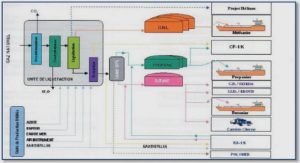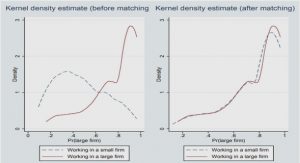Get Complete Project Material File(s) Now! »
SPEED OF ADAPTATION OF FOREST TREES TO CLIMATE CHANGE
Cycles of glacial and interglacial periods occurred on the earth’s surface for at least the past 2.7 million years, with glacial periods being characterized by a dry and cold climate. The previous period lasted 100 ka and ended 10 ka ago. The study of the pollen that was captured in sedimentary layers (palynology) highlights how plant species survived the previous glacial era and how they recolonize the land once it was free of ice in Africa, Australia, Europe and North America (Adams and Faure, 1997). These palynological surveys showed that hundreds of square kilometers that are now covered by forest in the Northern Hemisphere were covered by a large ice sheet. The biomes shifted across large distances, resulting in drastic modifications in ecosystem composition and connections, with many populations becoming isolated because of land and sea barriers. The primary forest tree genera are 15 to 60 million years old (Collinson 1992, Denk et al. 2002). Palynological surveys indicate that combining pollen data with charcoal and genetic data can be used to estimate the speed of latitudinal recolonization to approximately 100 m annually (Aitken et al. 2008). A body of studies has indicated that past climate changes were quite slow.
In contrast, the principal characteristic of the current climate change is its velocity (Loarie et al. 2009). According the IPCC (2007 report, Figure 1), “the intensity (variation / unit of time) observed and expected has never been reached since the last post-glacial warming”. For instance, near-surface temperature is expected to shift at mean rates of 80-430 m yr-1 during the 21st century for tropical, Mediterranean, temperate and boreal forests (Loarie et al. 2009), leading to shifts of trees bioclimatic envelopes from 300 to 800 km within one century. Besides, CC predictions (IPPC, Alcamo et al. 2007) suggest not only notable changes in near-surface temperature, but also in precipitation and in the frequency and intensity of heat waves, forest fires and pest outbreaks. The effects of the high velocity of climate change (CC) are reinforced by the small size of protected areas in Mediterranean and in some temperate forests, (Loarie et al. 2009) stressing the need to account for other components of GC (particularly land-use) when forecasting forest responses.
Forests are keystone species of terrestrial natural ecosystems. Forests are not a mere combination of certain woody species; rather, each tree is the habitat for numerous plants, animal and fungus species. This is particularly true for natural forests, which are generally highly heterogeneous and offer a broad range of ecological niches. Forests host as many as 80% of the world species and are a great
19
biodiversity reservoir.
One challenge is to understand whether forest trees can respond to the current rapid climate change. An ongoing debate that divides scientists can be approximately classified in three categories. First, certain optimistic scientists argue that trees populations may migrate to follow their respective climatic niche (e.g., Pauli et al. 2007, Parmesan and Yohe 2003, Penuelas and Boada 2003, Walther et al. 2002). Another category of optimistic scientists are convinced that trees populations have high levels of adaptive genetic diversity, which will confer them with a great adaptive capacity in face of climate change (e.g., Hamrick 2004, Petit and Hampe 2006). For yet others, climate change is occurring to rapidly to allow for tree populations to survive either through adaption or migration (e.g., Huges 2000, Davis et Shaw 2001, Thomas et al. 2004).
OVERVIEW OF THE CONCEPT OF LOCAL ADAPTATION
Adaptation was first defined as the process by which a novel character (or trait) is maintained by natural selection (Gould and Lewontin, 1979). When individuals exhibiting the new discrete character survive and reproduce better than individuals that lack the new character, the new character increases in frequency in the population in next generation. This ability of an individual organism to transmit its genes more or less efficiently to the next generation defines the fitness. The etymology of adaptation suggests a change “ad” toward a higher aptitude “aptus”. This notion of highest aptitude wrongly leads to the notion of evolutionary progress, with individuals/species becoming more complex. Another abuse described by the term adaptationism is the one consisting in incautiously considering a given trait as “functional” or “adaptive” (see Box 1 and Erreur : source de la référence non trouvée) is. An example is provided by the debate regarding leaf retention during winter by certain individuals of common oak (Quercus robur) and beech (Fagus sylvativa). Otto and Nilsson (1981) proposed that the retention of dry leaves during winter is an adaptive trait in the sense that it avoids the nutrients being flushed away during winter and allows for the litter to be enriched immediately prior to spring. However, considering this trait in the light of the phylogeny of Fagaceae family, Wanntorp (1983) noted that leaf retention is an ancestral character. Of over 1000 Fagaceae species, the majority are evergreen. Moreover, in oaks, a spectrum of leaf shedding habits can be observed, from long persistent to completely deciduous; these different habits are correlated with climate. Evergreen species are primarily located in tropical and Mediterranean regions, semideciduous species are found in intermediate habitats, and deciduous species reach north of Europe. As a consequence, specialization would not be leaf retention but, a contrario, deciduousness.
Since Darwin, adaptation in response to natural selection has been acknowledged to be a keystone concept in evolutionary biology, explaining how individuals suit their environment. Adaptation shapes the tree of life, but it is essentially occurring at local scale. As the forces of natural selection often vary through space, populations of the same species that are distributed within a heterogeneous environment are expected to evolve traits that increase individual fitness in a given habitat. This pattern and the process leading to it is local adaptation (Kawecki and Ebert 2004). In natural populations, it is generally difficult to assess the action of selection and to verify the adaptive advantages of a trait, which requires demonstrating that the trait under consideration is variable, heritable, and correlated to fitness (Endler, 1986).
Considering two populations A and B in distinct environmental conditions in which the optimum value ZOPT of the trait (the value conferring the highest fitness) differs among both populations (with the two respective values ZOPT-A and ZOPT-B), we expect divergent selection among habitat A and B to shift the distribution of the trait such that the distribution is ideally centered on the optimum value in each habitat (Kawecki and Ebert 2004). The establishment and maintenance of local adaptation is a balance between conflicting evolutionary forces (Yeaman and Otto 2011). Kawecki and Ebert (2004) stated the conditions in which local adaptation may occur: first, gene flow must be sufficiently high as to prevent isolation by distance but not too high to impede specialization; second, selection must be strong against maladaptive genotypes and moderate against intermediate genotypes; third, the temporal variation of selection forces must be very low; fourth, adaptive plasticity must not be favored.
MAIN APPROACHES BY WHICH TO DEMONSTRATE LOCAL ADAPTION
The primary approaches by which patterns of local adaptation in populations can be demonstrated are based on the analysis of either the phenotypic traits or molecular markers. Each approach has its advantage and disadvantages (Hansen et al. 2012). With respect to the traits-based approach, the primary difficulty is separating the portion of the variation that is under genetic control from that which results from environmental variation. A classical approach by which to assess local adaptation is to compare, through reciprocal transplant experiments, the relative fitness of the local vs. foreign genotypes within each habitat (Figure 3). Fitness must be ideally evaluated through lifetime experiments by measuring the contribution of each genotype to the successive generation. Alternatively, proxies of the genotype contribution to the next generation (fitness) may be used, such as vegetative biomass, reproductive output, and plant survival. The population growth rate proxy works quite well for small and short-lived organisms, such as bacteria (Belotte et al. 2003). In long-lived species, such as trees, the most common approach consists of investigating a performance trait, such as survival, fecundity, or growth, and considering it as representative of fitness (Rehfedlt et al. 2001 Savolainen et al 2007). The principal drawback of this approach is the limited knowledge of the relationship between the investigated performance trait and fitness. Moreover, directional selection may not act uniformly on the trait through the different stages of the individual’s lifetime. The resulting fitness depends of different traits each being under differential selection directions and strengths at different life stages. Moreover, reciprocal transplant experiments are occasionally not possible for legal or ethical reasons and frequently require unwieldy protocols that are hardly compatible with usual scientific project scales, particularly for long life cycle species.
Table of contents :
Introduction
1.Speed of adaptation of forest trees to climate change
2.Overview of the concept of local adaptation
3.Main approaches by which to demonstrate local adaption
3.1.Approaches to searching for signs of selection among populations
3.2.Approaches for searching for the signal of selection within a population
4.Disentangling the role of demography and adaptation in the interpretation of patterns of local adaptation
5.Latitudinal versus altitudinal gradient as models for investigating local adaptation
6.Objectives of the thesis
Chapter 1. Species and sites
1.Fagus sylvatica
1.1.Phylogenetic origin
1.2.The post-glacial distribution of Fagus sylvatica
1.3.Main physiological and ecological properties
1.4.Bud burst phenology
1.5.The genome of F. sylvatica
2.Mont Ventoux
3.The history of Fagus sylvatica on Mont Ventoux
Chapter 2. Candidate genes selection and SNP discovery
1.Context
2.Abstract
3.Introduction
4.Material and methods
4.1.Plant material
4.2.EST databases and annotation
4.3.Candidate gene selection
4.4.Primer design and gene amplification
4.5.Candidate gene sequencing
4.6.Data analysis
4.6.1.Phase reconstruction
4.6.2.Nucleotide diversity, LD patterns and recombination
5.Results
5.1.Gene selection, amplification and sequencing
5.2.Genomic diversity
5.3.Linkage disequilibrium (LD)
6.Discussion
7.Appendices
Chapter 3. Detection of loci under selection in Fagus Sylvatica along an altitudinal gradient: an outlier experimental approach
1.Context
2.Abstract
3.Introduction
4.Materials and methods
4.1.Study species and site
4.2.Candidate gene selection, sequencing and SNP validation
4.3.Genetic diversity, differentiation and linkage disequilibrium at candidate genes
4.4.SSR data
4.5.Frequentist outlier approach
4.6.Bayesian outlier approach
4.7.Relation between outlier SNP and traits
5.Results
5.1.Genetic diversity and differentiation at SNP and SSR markers
5.2.Frequentist outlier approach
5.3.Bayesian outlier approach
5.4.Patterns of between-population correlations for SNP pairs
5.5.Relation between outlier SNPs and functional traits
6.Discussion
7.References
8.Appendices
Chapter 4. Interaction between selection and gene flow in the building of genetic differentiation along an altitudinal gradient: lessons from an Eco-Physio-Demogenetic simulation model
1.Context
2.Introduction
3.Materials and Methods
3.1.The model and the simulated data sets
3.2.Measures of population differentiation
3.3.Patterns of genotypic and allelic frequencies across elevation
3.4.FST -based outlier approaches
3.5.Patterns of covariance among populations
4.Results
4.1.Patterns of genetic differentiation for the trait (FcritBB), the QTLs and the neutral loci
4.2.FST -based genome scan between populations Pop2 and Pop3
4.3.Patterns of genotypic and allelic frequencies across elevation
4.4.Inter-genic allelic correlation among populations Pop2 and Pop3
5.Discussion
5.1.Comparison with theoretical expectations
5.2.Global performance of FST -based outlier approaches
5.3.Performance of methods that are based on clines of genotypic frequencies
5.4.Performance of the between-population component of intergenic linkage disequilibrium (Zg)
6.Conclusion





